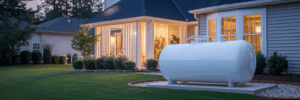
Why Your Propane Tank Needs Regular Attention
Propane is a quiet, reliable presence in over 14 million American homes, powering everything from cozy furnaces on winter nights to the backyard grill for a summer cookout. Its convenience is undeniable, but with that convenience comes a responsibility of ownership. Just like your car needs oil changes or your HVAC system needs filter replacements, your propane tank requires simple, consistent attention to function safely and efficiently.
Neglecting it can lead to service interruptions, costly repairs, or serious safety hazards. This isn’t about adding complicated chores to your list. It’s about understanding a few key habits that protect your home and family. This article will walk you through five common and preventable mistakes. Proactive care is the surest way to maintain a reliable fuel supply and gain complete peace of mind.
Mistake 1: Skipping Regular Visual Inspections
It’s easy to overlook the large, silent tank in your yard, but ignoring it is a significant risk. Small issues can become serious problems if left unchecked. A patch of rust might seem cosmetic, but over time it can corrode the steel and weaken the tank’s structure. A dent from a stray lawnmower or falling branch can compromise its ability to handle pressure safely. Learning how to inspect propane tank surfaces is your first line of defense.
Take a few minutes every few months to walk around your tank and look for specific signs of trouble. Pay attention to the surface, the paint, the valves, and the base. This simple visual check can alert you to developing issues before they escalate.
| Component to Check | What to Look For | Why It Matters |
|---|---|---|
| Tank Surface | Significant rust patches, deep dents, or gouges | Corrosion or damage can weaken the tank wall, creating a leak risk. |
| Paint Condition | Peeling, blistering, or chalking paint | The paint is a protective barrier; exposed steel is vulnerable to rust. |
| Valves and Fittings | Visible corrosion or signs of moisture | Corroded fittings may not seal properly, leading to slow leaks. |
| Tank Legs/Base | Instability, corrosion, or uneven ground | The tank must be level and stable to prevent stress on lines and fittings. |
Note: This checklist is for routine visual assessment. Any identified issues should be reported to a professional propane supplier immediately.
These homeowner checks are important, but they don’t replace a professional evaluation. We recommend scheduling a comprehensive inspection with a qualified technician every few years. They have the tools and training to check valves, regulators, and overall structural integrity, ensuring everything complies with current propane tank safety rules.
Mistake 2: Overfilling the Tank
More is not always better, especially when it comes to propane. You might notice your propane supplier only fills your tank to about 80% capacity, and there’s a critical safety reason for this. Liquid propane, like any liquid, expands when it gets warmer. That remaining 20% of the tank is not empty space; it’s vapor space, which gives the liquid propane room to expand safely as temperatures fluctuate.
An overfilled tank has no room for this expansion. On a hot day, the pressure inside can rise to dangerous levels. To prevent a rupture, tanks are equipped with a pressure relief valve designed to automatically vent excess pressure. While this valve is a crucial safety feature, it releases raw propane vapor into the air. If an ignition source is nearby, like a running air conditioner, static electricity, or even a lit cigarette, this vented propane can ignite, creating a severe fire hazard. This is why we stand firm in our belief that refills must only be performed by trained professionals who understand the physics and follow the 80% fill rule without exception.
Mistake 3: Ignoring Low Fuel Levels
Running out of propane is more than just an inconvenience that leaves you with a cold shower. It’s one of the most common propane tank problems and can introduce serious safety risks. When a tank becomes completely empty, the pressure inside can drop low enough for air and moisture to seep in. This moisture can cause internal rust, which is impossible to see from the outside and can compromise the tank’s integrity over time.
Even more concerning, air entering the tank can dilute the concentration of ethyl mercaptan. This is the chemical additive that gives propane its distinct “rotten egg” smell, which is your primary indicator of a leak. If the odorant is weakened, you might not be able to detect a future leak. Low fuel levels can also cause pressure to drop, especially in cold weather, which can extinguish appliance pilot lights. To avoid these issues, proactive fuel management is essential.
- Check your tank gauge regularly, particularly before winter and during extended cold snaps.
- Keep your tank level above 20% to ensure consistent pressure for your appliances.
- Consider arranging an automatic delivery schedule. This is the easiest way to ensure you never run out, and you can contact us to discuss a plan that fits your household’s needs.
Mistake 4: Storing Tanks Improperly
The rules for storing propane tanks safely are not suggestions; they are strict requirements for protecting your property and family. This is especially true for the smaller, portable cylinders used for barbecue grills, patio heaters, and other outdoor appliances. Direct sunlight and heat can cause the liquid propane inside to expand, increasing pressure and potentially triggering the pressure relief valve to open.
The most important rule is one you should never forget: propane tanks must never be stored indoors, in a garage, basement, or any enclosed area. A small leak in an enclosed space can allow gas to accumulate, creating a serious risk of fire or explosion. Tanks must always be kept outdoors in a shaded, well-ventilated spot, upright, and on a stable surface. They should also be kept away from any potential ignition sources, including open flames and electrical devices.
Keeping the tank in an upright position is also critical. This orientation ensures the pressure relief valve is in the vapor space at the top of the tank, not in the liquid. If the valve were to open, it is designed to release vapor, not liquid propane, which is far more hazardous. Whether you are using a small cylinder or have a large stationary tank, understanding the proper handling of our propane equipment is fundamental to safety.
Mistake 5: Neglecting the Surrounding Area and Appliances
Proper propane tank maintenance extends beyond the tank itself. The entire system, including the surrounding environment and the appliances it fuels, requires attention. You should maintain a clear zone of at least 10 feet in all directions around your tank. This area must be free of flammable materials like dry leaves, tall grass, woodpiles, or any combustible debris. Think of this clear space as a buffer zone; it removes potential fuel that could feed a fire and gives service technicians safe access to your equipment.
p>
Periodically inspect the lines, regulators, and fittings that connect your tank to your home. Look for any signs of cracking, brittleness, or other damage. Just as the tank is part of a system, your propane-fueled appliances are the final link in the chain. We recommend having your furnace, water heater, and other propane appliances serviced annually by a qualified professional. This ensures they are operating efficiently, venting correctly, and burning fuel safely. A well-maintained system, from tank to appliance, is key to enjoying all the benefits of our residential propane solutions.
Building a Simple and Safe Maintenance Routine
Maintaining your propane system doesn’t have to be complicated. By turning these five habits into a routine, you are taking simple, empowering steps toward home safety. Regularly inspecting your tank, ensuring it’s never overfilled, monitoring fuel levels, storing cylinders properly, and keeping the surrounding area clear are the cornerstones of responsible ownership. These are some of the most effective propane tank maintenance tips you can follow.
To make it even easier, create a personal maintenance calendar. Set a reminder in the fall to clear away leaves and debris, and another before winter to check your fuel level. This proactive approach prevents last minute problems and ensures your system is ready when you need it most. Remember, your propane supplier is more than just a delivery service; we are your safety partner. We are here to offer expert advice, professional service, and reliable deliveries. For more insights, feel free to explore our blog.
About Jennifer Whitaker
Propane industry expert and content contributor for MyPropane.com.
View all posts by Jennifer Whitaker →Related Articles

Essential Propane Management for High Use Farms
Nov 18, 2025 • 3 min read
Learn how to manage your farm's high-volume propane supply safely and effectively.

Five Propane Tank Mistakes That Risk Your Home's Safety
Oct 29, 2025 • 8 min read
Discover simple, effective ways to maintain your propane system and prevent hazardous situations with our straightforward advice.


